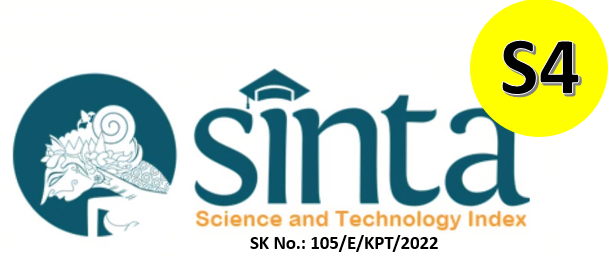Tofu Wastewater Treatment with the Growth Suspended Microorganism Using Different Air Flowrate
DOI:
https://doi.org/10.29080/alard.v7i1.1299Keywords:
tofu wastewater, growth suspended microorganism, air flowrateAbstract
This research discusses the processing of tofu wastewater with the aim of reducing and controlling the levels of pH, BOD, COD, TSS and temperature so as not to pollute the environment when dumped into rivers or other suitable places by simple reactors in few days. Water treatment process using bacterial from waste water as medium seems promising to develop since it does need any microorganism stater or other media like glucose. During the process of microorganism growth (seeding), the peak of MLSS was obtained on day 6 with 1560 mg/L. The other reason is wastewater from their wastewater processing is more suitable for microorganism cultivation because its effluent contains significant beneficial nutrienst and less of toxic compounds and harmful substances that interface with the growth of microorganism In same condition (pH and Temperature) in Acclimatization process can reach 77.45% after 7 days of treatment. After the detention time (18 hours) the results of COD number also greatly decrease with 5 hours recirculation with 8 L/min air flowrate and 86,51 % percentage of COD parameter decreased. This reseach is running in labolatory scale this problem must be recalculate to bring in large scale aplications, but this technology represents and effective, economilly and environmentally friendly process for tofu waste water treatment.
Downloads
References
Astuti, A. D. and Ayu, D. I, 2019. Treatment of Tofu Industry Wastewater using Bioreactor Anaerobic-Aerobic and Bioball as Media with Variation of Hidraulic Retention Time. Reaktor, Vol. 19 No. 1, March Year 2019, pp. 18-25
Bapedal. 1994. Environmental Insurance. Jakarta : Environmental Impact Control Agency.
East Java Governor Regulation Number 72 of 2013. (2013). Regarding Wastewater Quality Standards for Industry and/or other Business Activities
Ding, et al. Cultivation of Microalgae in Dairy Farm Wastewater without Sterilization. International Journal of Phytoremediation. DOI: 10.1080/15226514.2013.876970.
Faisal, Muhammad et al. Treatment and Utilization of Industrial Tofu in Indonesia. Asian Journal of Chemistry. DOI: 10.14233/ajchem.2016.19372 .
Fitrahani, L. Z. (2012). Characterization Of Operating Conditions And Process Optimization Of A Food Industrial Wastewater Treatment Plant. E-Jurnal Agroindustri Indonesia Oktober, 1(No. 2), p 110 - 117.
N, Sintawardani. 2011. Socio-Economic Problems on Reducing the Wastewater Pollution from Tofu Processing in the Cibuntu Area, Indonesia. Research Center for Physics Indonesian Intitute of Science.
Nagwekar, P. R. (2014). Removal of Organic Matter from Wastewater by Activated Sludge Process-Review. International Journal of Science, Engineering and Technology Research (IJSETR). Vol 3. no. 5: 1260–1263.
Matilda, F., Biyatmoko, D., Rizal, A., Abdulllah. 2016. The Improvement of Quality of Tofu Industry Wastewater Effluent on Activated Sludge System with Flow Rate Variation Using Ironwood (Eusideroxylon zwageri) Activated Charcoal. EnviroScienteae Vol. 12 No. 3, Nopember 2016 page 207 – 215
Martin, A. M. P., Heijnen, J. J., Van Loosdrecht, M. C. M., 2003. Effect od Dissolved Oxygen Concentration on Sludge Settleability. Applied Microbiology and Biotechnology. 62, 586-593
Ministry of Environmental RI, Number 15 of 2008 about Water Quality Standards Soybean Processed Industrial Waste.
Ridha, M. 2015. Promoting Eco-Friendly Production in Indonesia Tofu and Tempeh Industry. Impact Sheet-Switch Asia Project.
Shurtleff, William and Aoyagi, Akiko. 1975. The Book of Tofu : Food For Mankind. Autumn Press, Inc., Massachusetts. ISBN : 0-394-73431-9.
Tan, et al. Chlorella pyrenoidosa cultivation using anaerobic digested starch processing wastewater in an airlift circulation photobioreactor. Bioresource Technology, 170, 538-548. Doi:10.1016/j.biortech.2014.07.086 .
Sukma Budi Ariyani and Agus Sri. 2015. MulyonoThe Ability Of Mixed Culture Sludge From Industrial Waste Of Crumb Rubber To Ruduce Levels COD, BOD dan TSS. Majalah Biam Vol. 11, No. 1 Juli 2015, Hal 11-16.
Zahra, S. A., Sumiyati, S., Sutrisno, E., 2015. Reduction of BOD and COD Concentrations in Tofu Liquid Waste with Biofilm Pond Technology Using Fish Net Biofilter Media and Bioball. Environmental Engineering Study Program. Faculty of Engineering, Diponegoro University.
Downloads
Published
How to Cite
Issue
Section
License
Authors who publish with this journal agree to the following terms:
- Authors retain copyright and grant the journal right of first publication with the work simultaneously licensed under a Creative Commons Attribution License that allows others to share the work with an acknowledgement of the work's authorship and initial publication in this journal.
- Authors are able to enter into separate, additional contractual arrangements for the non-exclusive distribution of the journal's published version of the work (e.g., post it to an institutional repository or publish it in a book), with an acknowledgement of its initial publication in this journal.
- Authors are permitted and encouraged to post their work online (e.g., in institutional repositories or on their website) prior to and during the submission process, as it can lead to productive exchanges, as well as earlier and greater citation of published work.



